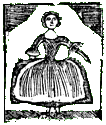Cancer Curers in Boston in 1790
I don’t know if doctors would consider all such growths as cancers today, but I have no doubt many cases of what we call cancer went undiagnosed back then.
It’s interesting to see that cancer medicine was already a specialty. Indeed, there were doctors who appear to have treated those growths and nothing else.
Osgood Carleton wasn’t even the only Bostonian offering both arithmetic lessons and a cancer cure in the 1790s. John Pope, a Quaker, had been advertising those services since 1779, and after he died in 1796 his wife Hannah took over on the cancer practice.
Toward the end of his career John used the title “Dr.” in his ads. Hannah listed herself as a “cancer doctor” in the 1800 town directory. The Popes’ sons also offered the family cancer cure in other New England towns, as I discussed back here.
To promote his cancer treatment, as quoted yesterday, Osgood Carleton shared testimonials from two women in Haverhill, where he had lived before settling in Boston. In his 1995 article on Carleton, David Bosse suggested that he might have learned this cancer treatment from John Pope, perhaps being the Haverhill agent for that cure.
I think that’s unlikely since Carleton declared that he offered “a Powder, of his own manufacturing,” and never mentioned the more established Pope as a mentor. Indeed, once Carleton moved to Boston, the men were in competition in two fields. I expect there wasn’t much love lost between them.
Unfortunately, cancer specialists like the Popes and Carleton kept their methods secret. That makes it hard to compare their cures, understand how these cures were supposed to work, and assess if they did.
However, the vital records of Haverhill do tell us more about the women who signed those certificates for Carleton in 1787. Elizabeth Lecount, daughter of James and Mary (Davis) Lecount, was born on 14 Sept 1729 and died 23 Mar 1829, or more than forty years after applying Carleton’s powder.
Eunice (Stuard) Cass, widow of William, died 18 Sept 1820. Her birth is not listed in those records, but she and William had children from 1758 to 1775, suggesting she was in her fifties in 1787 and in her eighties when she died. It’s possible the person who signed this certificate was that woman’s teen-aged daughter Eunice, born in 1770; she married Asaph Kendall in 1794 and lived to 1808. Either way, considering the awful symptoms the certificate described, that looks like a success.
TOMORROW: Cancer treatment in Salem in 1790.


